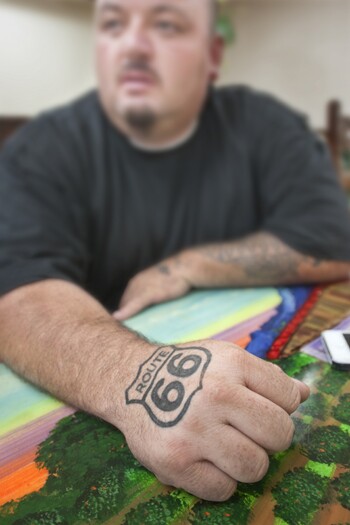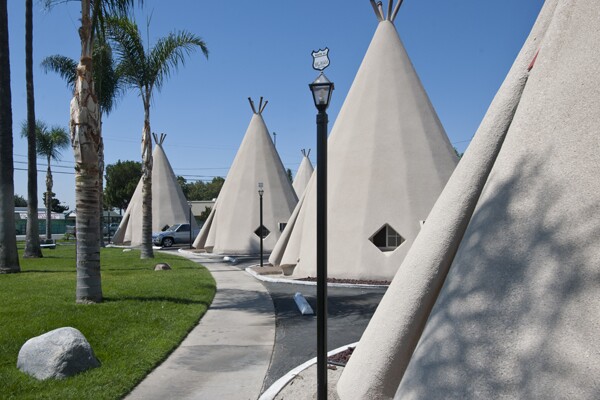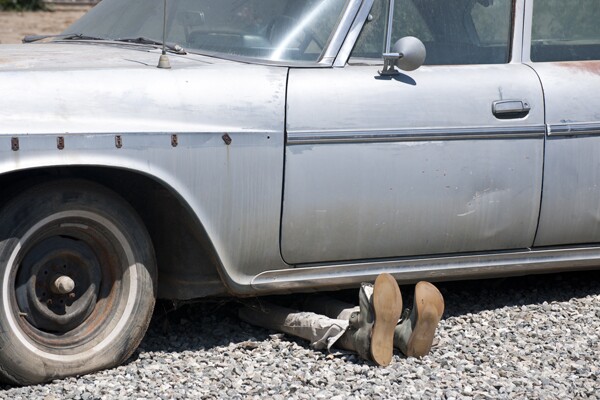Route 66 and San Bernardino Motor On, Despite Bankruptcy

Everybody knows the song, so maybe we should sing it to the city of San Bernardino. "If you ever plan to motor west, travel my way, take the highway that's the best. Get your kicks on Route 66. It winds from Chicago to L.A., more than two thousand miles all the way..." People still drive that historic route now, tourists from Europe and Canada and Asia, young people from New York and Chicago, hipster filmmakers and RV snowbirds. Bobby Troup wrote the song in 1946, and Nat King Cole and his band recorded it not long after that. It's been sung by everyone from The Rolling Stones to Depeche Mode to Brad Paisley.
But if you ever listen to the cool jazz piano and bass notes in the Cole version, or Troup's 1964 recording in Japan, you'll hear the hip part, and you'll hear those last two words roll off the tongue so mellifluous and beautiful. "Flagstaff, Arizona, Don't forget Winona, Kingman, Barstow, San Bernardino." The actual route ends in Santa Monica, but we remember those five syllables, and the lilt at the end -- even people who'd never imagined it knew that city's name.

Railroad town, Mormon settlement, birthplace of American and Mexican fast food stands which changed the way people eat -- right now San Bernardino's making national headlines because elected officials have filed for bankruptcy, but when I went twice last week to Route 66, a lot of people said what really outraged them: The city council said it couldn't host the Route 66 Rendezvous downtown, where it has been held for 22 years. People told me, "We didn't lose all that money -- the politicians did. They're saying they're broke, but we're still working! We're going to make it."
On May 20, 1810, Father Francisco Dumetz, scouting east from Mission San Gabriel, saw a valley with what looked like an arrowhead etched into the mountainside. (It might have been a massive landslide.) It was the feast day of Saint Bernardine, so he named the valley for her and established an outpost. In 1842, Jose del Carmen Lugo, grandson of a patriarch born in Sinaloa, Mexico, bought the asistencia for $800, and received a land grant of about 36,000 acres to create Rancho San Bernardino. Lugo and his family lived there, but after the United States annexed California, he was appointed the first alcalde (mayor) of Los Angeles under American control, in 1849.
In 1851, a Mormon wagon train from Utah made it over the Cajon Pass and stopped in a place known as Mormon Rocks. In 1852, Amasa Lyman and Charles Rich, Mormon leaders, bought Rancho San Bernardino from the Lugo family for $77,500. (Both the Lugos and the Mormons enlisted the Cahuilla tribe and the Trujillos of Agua Mansa for protection from cattle and horse thieves and bandits.)
Cautionary story: Don Lugo mortgaged his Los Angeles home and all his other property in 1854, to repay a loan he'd taken out at 5% interest compounded monthly. He lost everything, and by his death was completely broke.
How many of us can say our grandparents or great-grandparents came down that highway over the Cajon Pass and into the "Gateway City," and went west to begin new lives? My grandparents did, coming from Florida and settling in what they considered the paradise of Fontana. My ex-husband's family did, coming from Tulsa, Oklahoma to Los Angeles and the Inland Empire. His grandmother married a man who was an armed detective on San Bernardino's famed railways back in the early part of the century.

"This intersection right here, they came down from the mountains on Mount Vernon, and the route made a curve here. People turned the corner and went west and headed to L.A.," Albert Okura told me last week, standing in front of his Historic Route 66 museum. "This is a historic corner! But back in 1986, no one cared about the Route. Then the baby boomers started to retire, people bought Harleys, and the classic car guys started Route 66 Rendezvous. I wanted people to honor the route, so I started this."
Okura is the founder of Juan Pollo, and the restaurant's headquarters are behind him. To enter the museum, you go through the restaurant and open a door, and you are inside a former barber shop where assembly is ongoing of the charming and eclectic collection, really about California and dreams and cars. Vintage rusted gas pumps like I've never seen except in the desert, where he got them. Road signs, photos, maps, and history.

Okura loves the route so much he bought the town of Amboy in 2005, paying $425,000 in cash to the widow of the man who began the famous Roy's Café and Motel, much beloved by people all over the world who've seen the movie "Cars." Okura has restored the place, which looks timeless. (The tiny settlements along the route were named alphabetically -- Amboy, Bristol, Cadiz, Danner, Essex, Goffs -- by the railroad, for the places where engines needed water stops.) Amboy, where Roy's was started in 1936 for lonely, thirsty travelers, had its own International Route 66 celebration last weekend.
In the museum, one 1966 photo shows 27 cents bought a gallon at Douglas Gas on Baseline in San Bernardino. Driving west on Foothill Boulevard, which is Route 66 today, I looked for the Wigwam Motel, just over the line in Rialto. My mother told us about it, because her first job was in San Bernardino, back in the 1950s, right when the Wigwam Motel's teepees were gleaming white and new, single rooms set inside giant cones on circles of red gravel and arranged in new crescent moons around the palm trees.


Samir Patel was behind the reception desk of the Wigwam last week, and he showed me vintage and new photos of the world-famous motor court. Frank Redford designed the Wigwam franchise, Patel told me. "The Wigwam was built in 1950 -- the first rim," he said. "There were seven in the chain, but #6, in Holbrook, Arizona, isn't in the franchise. We're #7, and he built this one and actually lived here in #1. He had a barbecue pit, and his office, right there."

Samir was born here in San Bernardino, along with his brothers, but his parents Jagdish and Ramila Patel came here from the city of Navsari, in Gujurat, India, during the 1970s. They bought the Wigwam, which was deteriorating badly, in 2000, and renovated it so carefully that they received an award in 2005 for historic preservation, and the place is being considered for the National Register of Historic Places. On a blistering 109 degree day, Samir and his grandfather are behind the desk, along with his mother and other relatives who are doing maintenance. "We get people from all over the world, and from New York, Texas, Oklahoma," he said. "They start in Chicago, end in Santa Monica, but they want to stay here when they're done driving the desert."

There's a velvet-cushioned antique couch in the back parking lot, left by a film crew doing a fashion shoot, near a collection of vintage vehicles that decorate the second rim. Legs and feet stick out from under one car, as if a phantom is forever working on the brakes -- paying tribute to all those who broke down, like the Joads in Grapes of Wrath and even later. "One couple came recently," Samir said, adjusting the feet. "They were married in L.A., driving to Palm Springs for their honeymoon and their car broke down. They spent their wedding night here, and fifty years later they came from Florida to spend their anniversary here."
On the office wall is a custom-designed t-shirt featuring the motel's sponsorship of The Rendezvous. The Wigwam is fully booked during that week in September, and Albert Okura is also a sponsor. How can politicians in a city where people worked so hard for decades -- at farming and then railroads, at nearby steel mills and raceways, in the citrus groves and wineries, and at hotels and restaurants all along the avenues -- gamble on the life of the place? (DJ Waldie's post here on KCET about the "hollowing out" of great California cities mentions specifics.)
Coincidentally, I met Larry Abeyta, a UPS delivery driver, this week. Abeyta was born in East L.A., but has lived in Rialto for many years, and considers himself an IE guy now. "I just registered my 1966 Chevy C-10 truck in the Rendezvous!" he told me. He's trying to convince his wife Debra to enter her Corvette. They'll take their RV and kids to camp at the Carousel Mall in downtown SB, showing the truck, barbecuing and having fun with the thousands of others who will gather there. Abeyta, and others, told me the city makes more than $1 million on the event. Yet the city council said that because of the budget deficit and bankruptcy filing, they couldn't provide police or emergency services, and wanted to cancel the event or move it to Glen Helen Regional Park and charge a fee.
But a native son stepped in. Jack Brown, born in San Bernardino, who got his first job as box boy at a local market when he was 13 and his father died, is the CEO of Stater Bros, the largest employer in SB and Riverside Counties with more than 18,000 workers and 167 stores in Southern California. Stater Bros opened its first grocery store in Yucaipa in 1936, when those desperate families rode down Route 66. The Rendezvous' title sponsor provides $600,000 worth of cash, printing services, employee volunteer time and vendor concessions to the show, Brown said, adding that he wanted to keep entry to the Rendezvous free of charge and to keep the event in San Bernardino. The Convention and Visitors Bureau's board of directors made the decision to keep the annual car show downtown during a special meeting. The four-day event is expected to attract up to 500,000 people.
Cruising down E Street was as much a part of Inland Empire life as cruising Whittier meant East L.A. and cruising Crenshaw meant South Central L.A. When I was in high school, classic car guys always talked about E Street as the place to show off the best of the best. Elected officials might have spent money on an airport that isn't there, on redevelopment that didn't work, and on things people can't even imagine. But Larry Abeyta told me, "My Chevy was Registrant 975, so I know people are still all coming out." In 106 degree heat, he had just delivered a water filtration system for produce at the Stater Bros facilities. Abeyta and Jack Brown, along with the Patels and Albert Okura, are still working.
"Won't you get hip to this timely tip, when you make that California trip, get your kicks on Route 66."
Next post: Albert Okura and the Fast Food History of the Inland Empire
Susan Straight's new novel "Between Heaven and Here" will be published September 12 by McSweeney's Books. Her novel "Highwire Moon" is about a California-born daughter searching for her Mexican-born mother. Doug McCulloh's photographs have been exhibited across the U.S. and in Mexico, Europe, and China. His fourth book "Dream Street" chronicles the builders, workers, and homebuyers of a subdivision in Southern California. Read more of their stories here.


